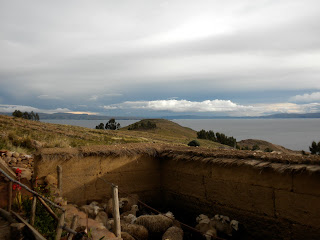After we had all presented our independent study projects and said our goodbyes, my Dad flew down for a few weeks of good ol’ father-daughter traveling. We spent a few days in Cochabamba staying with my homestay family, visiting the city’s biggest market (la Cancha) and attending a La Paz vs. Cochabamba soccer match. The game was wild... complete with fireworks, outrageous chants and riot police. We spent a day in La Paz and somehow managed to walk by the presidential palace as Evo Morales and Vice President García Linera walked out the doors. Then we headed to Puno, Peru and visited several islands off the coast in Lake Titicaca. First stop was at the Islas Flotantes (Floating Islands) of the Uros people. They were originally constructed by the Uros to escape an Incan invasion on the mainland and have survived to this day largely due to tourism. It was fascinating to walk on the teetering reed structures and observe their way of life, but the whole experience also seemed fairly inauthentic to me. While I would rather leave this community to itself and removed from western influence, it is hard to come to that conclusion when their current livelihood mostly comes from tourism. After three more hours on the boat we stopped for lunch of trout and king fish on Isla Taquile, where they were holding a ceremony to bring forth a good harvest. Finally, we ended up at Isla Amantaní for a one-night homestay. We had a great time walking about the island at sunset, talking with the family in the kitchen and watching the donkeys bring in loads of harvested fava beans.

Next, we headed up to Cuzco to begin our marathon tour of Incan ruins. The city itself was very fun to explore, despite the crazy amounts of tourists roaming about. We were able to meet up for dinner with my cousin Emma and her boyfriend Matt who have been traveling all over South America since February. It was great to see them and hear their tips on attractions around the area. We visited the Incan water temple, Sauksayhuaman (or “sexy woman”, as American tourists call it), Moray, the Salineras de Maras, Ollantaytambo, Machu Picchu, and some pre-Incan ruins too. The Salineras (Incan Salt Pans) were especially striking. The Incas diverted a salty spring into hundreds of rectangular plots, which they left to dry and then used the leftover salt to preserve meat. The site is still in use today, as families pass down their own plots to new generations. Machu Picchu was also incredible. The ruins are extremely impressive and well preserved but my favorite part was hiking to the top of Huayna Picchu for an amazing view of the ruins from above, the winding Río Urubamba below and the surrounding jungle. I even found Tom (a student from my program in Bolivia) at the top!


We spent our final day in Lima, the country’s capital along the Pacific Coast. Our ride on the city bus into downtown to find the main plaza was both hysterical and terrifying. The driver accelerated and braked so quickly and frequently that passengers were constantly falling over as they stood up to get off. Though I wasn’t a huge fan of Lima’s chaotic traffic and relentless smog, we definitely enjoyed the beautiful Spanish architecture and fresh ceviche!
After three wonderful weeks of family, friends, relaxing (and lots of hiking!) in Portland, I headed to Tucson, Arizona for an internship with Border Action Network. BAN is a non-profit organization that does a mixture of policy advocacy, litigation, and grassroots community organizing for immigrant and border communities throughout Southern Arizona. Most of our work so far has revolved around Senate Bill 1070, which is planned to take effect July 29th. The law will require police officers enforcing any state, county or municipal law or ordinance to determine the person's immigration status when there is reasonable suspicion he or she might be undocumented. I’ve been holding a number of “house parties” in the homes of our members to inform their friends and family members on the most relevant aspects of the law and how they can best protect themselves. The people have been extremely generous, inviting me to share meals with their families and go to church with them. I love these times when I’m getting to know the real people of the organization on an individual level. Using my Spanish on a daily basis is also a plus. I’ll try and keep you updated as things pick up throughout the summer.






